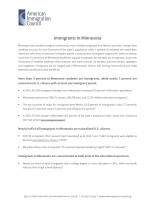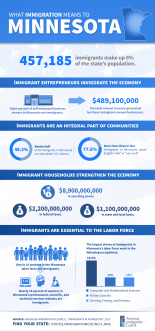- Fact Sheet
Immigrants in Minnesota
Published
Minnesota has a sizable immigrant community, much of which emigrated from Mexico and Somalia. Foreign-born individuals account for nearly one in ten Minnesotans, while 7 percent of residents are native-born Americans who have at least one immigrant parent. Across sectors, immigrants support the state’s economy. For example, one in five Minnesota healthcare support employees is an immigrant, as are nearly one in five residents working in the computer and math sciences. As neighbors, business owners, taxpayers, and workers, immigrants are an integral part of Minnesota’s diverse and thriving communities and make extensive contributions that benefit all.
Nearly 10 percent of Minnesota residents are immigrants, while 7 percent of residents are native-born U.S. citizens with at least one immigrant parent.
- In 2018, 484,192 immigrants (foreign-born individuals) comprised 9 percent of the population.
- Minnesota was home to 226,546 women, 210,832 men, and 46,814 children who were immigrants.
- The top countries of origin for immigrants were Mexico (12 percent of immigrants), Somalia (8 percent), India (6 percent), Laos (5 percent), and Ethiopia (5 percent).
- In 2018, 417,832 people in Minnesota (7 percent of the state’s population) were native-born Americans who had at least one immigrant parent.
More than half of all immigrants in Minnesota are naturalized U.S. citizens.
- 255,008 immigrants (53 percent) had naturalized as of 2018, and 81,309 immigrants were eligible to become naturalized U.S. citizens in 2017.
- Four in five (81 percent) immigrants reported speaking English “well” or “very well.”
Immigrants in Minnesota are concentrated at either end of the educational spectrum.
- More than a third (34 percent) of adult immigrants had a college degree or more education in 2018, while nearly a quarter (24 percent) had less than a high school diploma.
|
Education Level |
Share (%) of All Immigrants |
Share (%) of All Natives |
|---|---|---|
|
College degree or more |
34 |
37 |
|
Some college |
22 |
34 |
|
High school diploma only |
20 |
25 |
|
Less than a high school diploma |
24 |
5 |
|
Source: U.S. Census Bureau, 2018 American Community Survey 1-Year Estimates. |
||
More than 64,000 U.S. citizens in Minnesota live with at least one family member who is undocumented.
- 95,000 undocumented immigrants comprised 20 percent of the immigrant population and 2 percent of the total state population in 2016.
- 138,664 people in Minnesota, including 64,136 U.S. citizens, lived with at least one undocumented family member between 2010 and 2014.
- During the same period, about 4 percent of children in the state were U.S. citizens living with at least one undocumented family member (48,292 children in total).
Minnesota is home to over 5,000 Deferred Action for Childhood Arrivals (DACA) recipients.
- 5,180 active DACA recipients lived in Minnesota as of March 2020, while DACA has been granted to 6,500 people in total since 2012.
- As of 2019, 59 percent of DACA-eligible immigrants in Minnesota had applied for DACA.
- An additional 2,000 residents of the state would satisfy all but the educational requirements for DACA, and fewer than a thousand would become eligible as they grew older.
More than one in ten workers in Minnesota is an immigrant, together making up a vital part of the state’s labor force in a range of industries.
- 326,010 immigrant workers comprised 11 percent of the labor force in 2018.
- Immigrant workers were most numerous in the following industries:
|
Industry |
Number of Immigrant Workers |
|---|---|
|
Health Care and Social Assistance |
65,425 |
|
Manufacturing |
63,707 |
|
Retail Trade |
35,742 |
|
Educational Services |
29,921 |
|
Accommodation and Food Services |
29,737 |
|
Source: Analysis of the U.S. Census Bureau’s 2018 American Community Survey 1-year PUMS data by the American Immigration Council. |
|
- The largest shares of immigrant workers were in the following industries:
|
Industry |
Immigrant Share (%) |
|---|---|
|
Administrative & Support; Waste Management; and Remediation Services |
16 |
|
Manufacturing |
14 |
|
Transportation and Warehousing |
14 |
|
Accommodation and Food Services |
14 |
|
Health Care and Social Assistance |
11 |
|
Source: Analysis of the U.S. Census Bureau’s 2018 American Community Survey 1-year PUMS data by the American Immigration Council. |
|
Immigrants are an integral part of the Minnesota workforce in a range of occupations.
- In 2018, immigrant workers were most numerous in the following occupation groups:
|
Occupation Category |
Number of Immigrant Workers |
|---|---|
|
Production |
45,478 |
|
Office and Administrative Support |
33,048 |
|
Transportation and Material Moving |
30,108 |
|
Sales and Related |
28,167 |
|
Building and Grounds Cleaning & Maintenance |
25,314 |
|
Source: Analysis of the U.S. Census Bureau’s 2018 American Community Survey 1-year PUMS data by the American Immigration Council. |
|
- The largest shares of immigrant workers were in the following occupation groups:
|
Occupation Category |
Immigrant Share (%) |
|---|---|
|
Healthcare Support |
20 |
|
Building and Grounds Cleaning & Maintenance |
19 |
|
Production |
19 |
|
Computer and Mathematical |
18 |
|
Architecture and Engineering |
14 |
|
Source: Analysis of the U.S. Census Bureau’s 2018 American Community Survey 1-year PUMS data by the American Immigration Council. |
|
- Undocumented immigrants comprised 2 percent of Minnesota’s workforce in 2016.
Immigrants in Minnesota have contributed billions of dollars in taxes.
- Immigrant-led households in the state paid $2.9 billion in federal taxes and $1.5 billion in state and local taxes in 2018.
- Undocumented immigrants in Minnesota paid an estimated $191.2 million in federal taxes and $108.8 million in state and local taxes in 2018.
- Minnesota DACA recipients and DACA-eligible individuals paid an estimated $14.9 million in state and local taxes in 2018.
As consumers, immigrants add billions of dollars to Minnesota’s economy.
- Minnesota residents in immigrant-led households had $11.2 billion in spending power (after-tax income) in 2018.
Immigrant entrepreneurs in Minnesota generate hundreds of millions of dollars in business revenue.
- 20,219 immigrant business owners accounted for 7 percent of all self-employed Minnesota residents in 2018 and generated $576.2 million in business income.
- In the Minneapolis-St. Paul-Bloomington metropolitan area in 2018, 11 percent of business owners were immigrants.
We can't let the government keep us in the dark.
Join us in demanding transparency and holding them accountable in court to protect our democracy.
Donate Now

